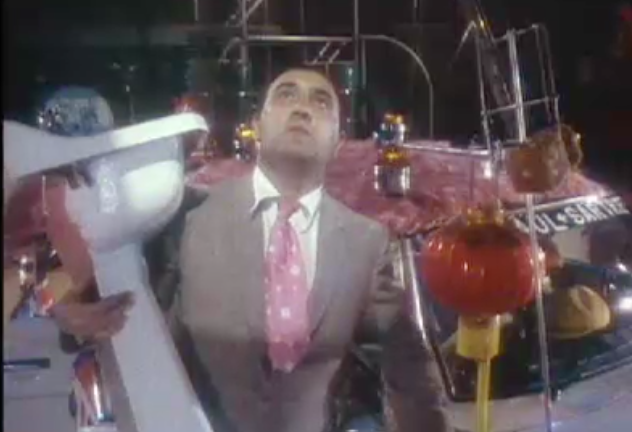by Michael Hrebeniak, Magdalene College Cambridge / New School of the Anthropocene
Over four decades and 700 programmes the composition of a bottle afloat on a moonlit sea containing a single word in simulated neon beneath Brian Eno's 'Another Green World' has served as a portal to another order of the real. The haunting sequence marking Arena’s reconfiguration in 1979 as a filmic strand under the stewardship of Series Editors Nigel Finch, Anthony Wall and Alan Yentob would announce a dramatic invasion of the documentary’s supposed facticity by the full range of avant-garde representational sleights.
While the documentary form could be more traditionally regarded as a stable referent in the space of discourse, Arena engaged with the networked nature of contemporary epistemic pressures to create a distinctive poetics of the televisual essay. This, of course, takes place within an era marked by the enhanced visibility of crises brought about by Britain’s anxious redefinition in the face of its lost imperial power and the haemorrhaging of sovereignty to the European Union, alongside ancillary pressures of globalisation, the social violations of Thatcherism and the Soviet Union’s slow collapse.
The subjects of Arena’s programmes were framed by the UK's concomitant revolutions in cultural identity and demography. In refusing distinctions between the popular and the learned, Arena interrogated models of sanctioned taste inherited from Matthew Arnold that still dominated broadcasting and actively led the comprehension of these changes to television audiences. Alongside canonical figures such as T.S. Eliot, Luciano Pavarotti, Samuel Beckett, Marc Chagall and Orson Welles, Arena generated the first serious televisual examinations of outriders like Louise Bourgeois, Bob Marley, Poly Styrene, Cindy Sherman and Bill Shankly, alongside inventive engagements with the themes of material culture, such as the Chelsea Hotel, Elvis Presley’s diets, corporate prize giving and the multiple versions of Frank Sinatra’s capitalist Internationale, ‘My Way.’
Arena’s programme styles reflected the radicalism of their subjects, which were located inside complex forms of mediation rather than settled chronologies of events, dates and personalities. This comprised a performative demonstration of the cultural shifts that it mapped. Whereas documentary film typically simulated a text through the unfurling of discrete images in linear sequence, Arena’s films were laden with metadata, unbidden associations and diversions, which laid bare the mechanics of their form. A director’s lens could commonly be trained upon the apparatus of mass mediation with sequences shot through cinematic interiors, reveries over fax machines, overheard conversations, ear-wigged telephone calls, quoted newspaper reports, clips accrued from cathode-ray tubes and snatches of radio broadcasts, none of which conventionally lent themselves to televisual pleasure.
The programme’s cutting together of new and historical footage was particularly revolutionary. Whereas the documentary's conventional use of archival material suggested a transference of the displaced event into the present as a means of reinforcing a seamless continuity, Arena’s directors treated the screened past as a palimpsest of spectral traces or disruptive diegeses. This contributed to the cultivation of a televisually-literate audience, unusually alert to representations that could be classed as 'metamorphic,' to call on Jacques Ranciere's term for destabilising images that acknowledge differing modes of data assimilation, as opposed to the 'ostensive' documents of mere testimony.
Such features undergird Arena’s long-term aesthetic continuity, which points to the essentially collaborative nature of the filmmaking enterprise. A roster of internationally renowned directors would somehow balance the individuality of their subject matter and technique with an identifiable contribution to the strand’s distinctive architecture and rhythm: its interplay of materiality, moral value and intellectual disposition; and its understanding of intermediality, of openly existing within an established universe of forms that brooks no restriction. This was extraordinary for a mass-media programme that attracted audiences of up to nine million in the 1980s.
Any number of Arena’s documentaries might testify to this appraisal, but I shall focus briefly on a single early exemplar: The Private Life of the Ford Cortina, directed by Nigel Finch and broadcast in January 1982. Its subject was the saloon vehicle that moved through five marks from 1962 before ceasing manufacture twenty years later. This was the UK's most popular car of the 1970s with more than 2.8 million models sold. The Cortina had originally been aimed at buyers of the Vauxhall Victor and Morris Oxford, superseding associations of car ownership with industrial muscularity and tweedy university towns with the exotica of Cortina d'Ampezzo, the ski resort that hosted the 1956 Winter Olympics.
The mystique of unlimited individual mobility through car ownership was thereby reinvested with the glamour of continental high-life, newly accessible through package-deal holidays. Accordingly, the first brochure for the Mark I featured simulations of passport stamps, photographs of parasols on sun terraces, car boots full of suitcases, sunhats and wicker-covered flasks of Chianti. The saloon’s strategic positioning within a lifestyle orbit would extend to the Mark IV’s unlikely previewing in the 1977 James Bond film, The Spy Who Loved Me, further reinforcing automobile culture’s tangled relations with unaccountable asocial power in the eyes of the prospective male buyer.
For the programme makers, the Cortina served as an aperture, not only for considering the automobile’s role as the central organising device of the twentieth-century built-ecology, but also the 'system of socially learned dispositions, skills, tastes and ways of acting that are often taken for granted,’ which Pierre Bourdieu defined as the ‘habitus’ operating beneath the level of ideology to ‘produce the human.’ The subject of the Cortina accordingly integrates concerns of industrial production, toxic pollutants, communications technology, the semiotics of class and fashion, the question of physical prowess through prosthesis - Marshall McLuhan observed that men do not enter cars but put them on – and shifts in temporal-spatial awareness. The film acutely grasps the contemporary depiction of the body-car as vehicle for the urban performance of hyper-masculinity: a carapace for the displaced libido reflected in the egregious sexism characterising Cortina marketing campaigns, designed to compensate for male anxieties over the loss of authority within changing labour patterns.
The levels of the technical, social and everyday thus interfuse in this symbol of modernity. The forging of interdisciplinary forms of engagement are registered in Finch’s unique approach to data gathering, which moves beyond questions of fetishising the commonplace to finding new performative modes of confrontation within complex cultural processes. This is typical of Arena’s corpus: a cutting across discursive decorum as a test of representational possibility. The resulting programmes are vigorously heteroglossic, accommodating all kinds of aberrant intrusions to confer an awareness of filmic materiality and the kinds of counter-intuitive comprehension that only art might produce. This is fully articulated in Cortina by fusions of choice and indeterminacy; poetic devices such as over-extended takes, sudden ruptures, tableaux and non-illustrative music; a lingering over balletic lines of Cortinas weaving through country estates; poetry recitals (unremittingly awful); a seemingly gratuitous lack of action; and the refusal of a conventional subjectivity, which is routinely assigned by the camera’s gaze to the object of the car or, at best, its half-man/half-Cortina owner.
Such effects disrupt any illusion of an unmediated reality upon which the traditional documentary ostensibly reposes. The film’s engagement with the cultural eddies surrounding a mass-produced machine elude any sense of a locatable teleology or ideological stance, and jettison all claims to exhaustive meaning. Official and popular cultures of the era are instead cast into a swarm of cross-referencing. Scenarios are assembled to encode and celebrate an existential provisionality with the editorial cuts assigning no definitive order. The temptations of middle-class sneering and Warholian indifference, alike, are displaced by a non-judgemental curiosity regarding cultural practices, which are often underscored by palpable skill, as seen, for example, in the car auctioneer’s limpid oratory.
The film leaps around the iconic settings of the British automobile landscape – suburban streets, garages, motorway flyovers, showrooms – for its settings. The concrete underworld of an aerial bypass frames the design-historian, Stephen Bayley’s deconstructions of the Cortina’s index of social status, intercut with commentaries from the Ford Motor Company boardroom about the predatory apparatus of customer-profiling within a proudly gendered discourse. ‘Ninety percent tend to be male,’ discloses a marketing executive, ‘holding managerial responsibility and earning more than the national average,’ as his image montages into archive footage of a human hunting satire.
Prior to this we chance upon a simulation of the 1970’s quiz show, Mastermind, with Magnus Magnusson reconjuring his own illusionistic framework inside the world of documentary with comedian and ‘Automobile Sociologist,’ Alexie Sayle, in the contestant’s chair. Sayle’s clownish gait, wide-boy persona and edge-of-psychosis fury threatening eruption from within his tortuously pinched suit serves as the film’s coordinating device across scenes, which include an in-character consultation with ex-armed robber, John McVicar, over the Cortina’s propensity for ramming security vans. A modish suburban couple then read a love-letter to Ford’s directors about their use of the Mark III as marital prosthesis, while commemorating 100,000 miles of service: their illustrative Kodak-Colorplus snaps, integrated brown furniture and clothing ensemble, and uneasy comportment on a sofa serving as a gestalt for the historicised particularities of the body’s domestic techniques and rhetoric.

Arena: Private Life of the Ford Cortina (Dir: Nigel Finch), BBC2, 19th January 1982
We then witness the Cortina Owners’ Club gathering at ‘Rally Control’ and its prize-giving choreographies featuring men holding detailed technical discussions with arms crossed over exposed engines, complementing shots of purposeless waiting and implausibly compliant wives. Men in deckchair footage predominates. This performance of consumer fetish adoration is accompanied by the recording of a Palestrina Magnificat, such daring fissures being typical of Arena’s asynchronous strategy of audio-visual dissociation. The focus then swerves to a company pool car overseer for travelling salesmen, who explains that the Cortina’s generous size is vital to his company’s image, while drawing attention to the ratio of its luxury gradations to the strata of managerial pay-grades. Various stylised scenarios of subcultural male display then emerge, hovering between lived and dreamed experience with footage of customised bodies and rebuilt engines ‘befitting the psychological as well as functional requirements of the young male,’ to quote a Ford executive-clinician.
Deference is also paid to the conspicuous Thatcherite male bling of gold jewellery, logo’d schmutter and the permed highlighted hair characteristic of the terrace casual hitched to Cortina ownership, with interiors adorned by fluffy seat covers and over-sized furry dice suspended from rear-view mirrors to simulate the surfaces of animals; indicative, too, of the era’s unspoken understanding of the car as site for fugitive sexual encounter. Within a few minutes the fanfare from Richard Strauss’ Thus Spoke Zarathustra - associated in that era with coverage of the Apollo space-exploration mission and, by implication, the transgression of species limits - underscores the opening of a garage door on a suburban housing estate to reveal a comically over-endowed Mark III shrouded in dry ice, its owner speaking of his narcissistic pleasure in seeing reflections of himself in plate glass while driving through urban environments, and the word ‘SATISFACTION’ inscribed in burning capitals upon his car hood. ‘It’s really nice,’ he explains.
In each instance the commodity code is rehearsed and then dynamically disrupted through the programme’s editing strategy. This extends to the dated critiques of misogyny within contemporary automobile marketing, as configured by the image of women in mechanics’ overalls draped louchely over a Cortina bonnet in a heavy-handed satire of trade show practices: arguably an emulation rather than critical interrogation. Ditto the bizarre interview with the pornographic actress, Fiona Richmond, in a Cortina passenger seat, offering an obliquely feminist critique of a 1971 television advertisement for the Mark III while dressed in a negligee. Such scenarios illuminate the mass media’s intensifying meta-engagement with its own misogyny and should be productively historicised as such.

Arena: Private Life of the Ford Cortina (Dir: Nigel Finch), BBC2, 19th January 1982
More positively, a young black South Londoner is filmed servicing a Mark II outside his garage against the sound of reggae from his portable cassette player, the music radiating synchronically from inside the shot to signal agency, rather than patronisingly overlaid from without. Televised images of black men in British urban environments in 1982 would more typically carry connotations of alienation and threat, with footage of the previous year’s Brixton riots widely transmitted and often repeated in news and documentary broadcasts. Across print media second-generation Caribbean teenagers were uniformly configured as folk devils, frequently expelled and decanted into ‘educationally subnormal’ schools, and stopped and searched under ‘sus laws’ adapted from the 1824 Vagrancy Act for the crime of walking in a street. But here we see a skilled mechanic, participating in mainstream consumer culture – he proudly declares ownership of three Mark IIs and a Mark I – speaking knowledgably of the Cortina as the ‘black man’s Rolls Royce’ and driving a top of the range Mk II model, albeit with a bashed front wing and replacement boot panel of a different colour.

Arena: Private Life of the Ford Cortina (Dir: Nigel Finch), BBC2, 19th January 1982
The representation of these signatures of civic performance combines realism and heightened, or even theatrical, levels of image-making and sound. The effect is of a performative sociological cross-section of the Cortina’s orbit: a compendium of part-vanished cultural practices and a museum of the transitory, the marginal and the in-between. These encounters are the stuff of the recent past, but we experience them as seemingly ancient, once the lives and social relations they have incubated pass into memory. The binaries of public and private life shatter in what Maurice Blanchot terms ‘moments of effervescence – those we call revolution – when existence is public through and through.’ Not only the Cortina, but the entire transactional economy of those commonplace environments and behaviours that the car mediates are historicised within the programme’s contested space. Jacques Derrida’s observation that there can be no archive without 'consignment in an external place which assures the possibility of memorisation, of repetition, of reproduction,' remains particularly salient to a popular medium expressly concerned with the quotidian, but too often derided as fleeting and disposable.
Finch’s film, as is typical of Arena’s corpus, can therefore be regarded as a commemoration of cultural impermanence via the very medium of ephemerality. The result is not only a unique record of civil practices but a primary document in and of itself: one that registers a valorisation of a utilitarian device destined to disappear; and a hymn to collective memory that resists the accelerating junking of mass-produced objects into scorned obsolescence.
© Michael Hrebeniak, April 2022
About the Author
Michael Hrebeniak’s book-length study, Bottled Neon: The Poetics of BBC Arena, will be published by the BFI in 2024. He is Convenor of the New School of the Anthropocene in association with October Gallery London, and is Lecturer in English at Magdalene College Cambridge. He has written widely on the Beat Generation, jazz, ecopoetics, cinema, photography and the 1968 uprisings. His first film, Stirbitch: An Imaginary was premiered in 2019 at the Heong Gallery. He previously worked as a researcher and producer for Channel 4 TV.
